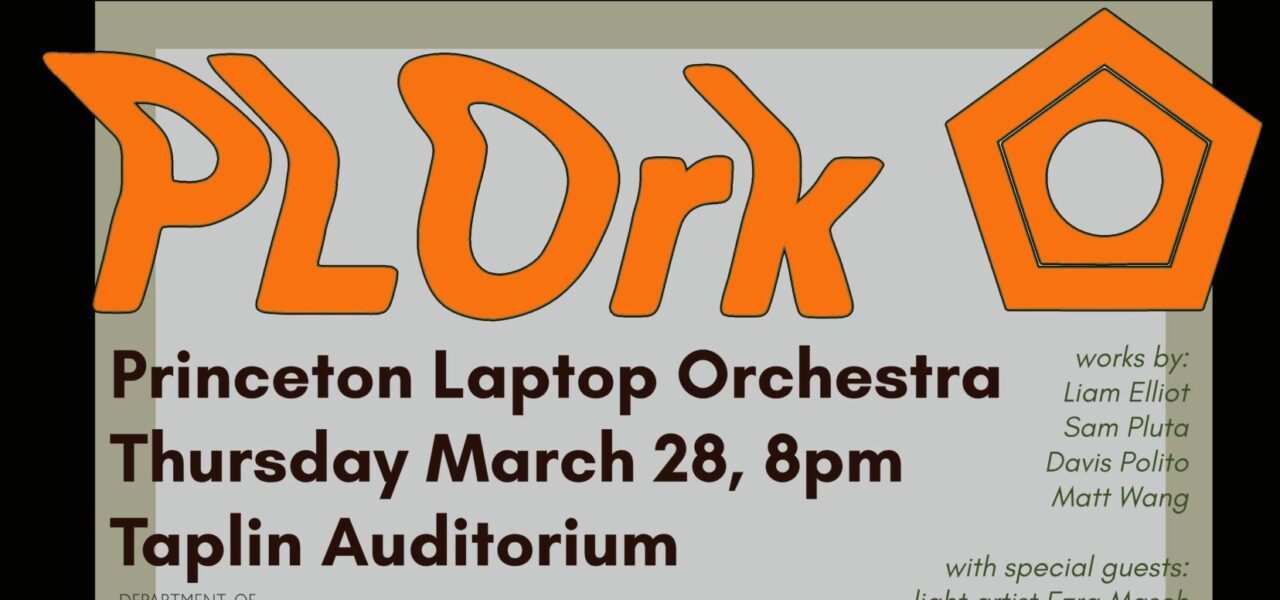Please consult our COVID-19 policies and resources for guidance on attending public performances.

PLOrk: Sound System
Presented by Princeton University Music Department
date & time
Thu, Mar 28, 2024
8:00 pm - 10:00 pm
ticketing
Free, Unticketed
- This event has passed.

PLOrk, (the Princeton Laptop Orchestra) presents “PLOrk: Sound System“, featuring guest artists Evan Chapman (drummer of Square Peg Round Hole) and light artist Ezra Masch. This special program, performed on electronic and acoustic instruments, features a custom-built drum-controlled light sculpture installation, two enormous subwoofer speakers that are activated by climbing inside them, a strange multiplayer video game where the performers turn screen pixels directly into sound, and a piece that uses the audience’s cellphones as its instrument.
We invite the community to experience the sounds and sights of these new experiments in sound and light.
Program
Liam Elliot New Work
PLOrk Extruded Curve
Sam Pluta Photokeratitis (for David Tudor)
Matt Wang Setup, Play, Teardown
Daby Baby Low End Theory
About
Ensemble Members
Ian Accetta
Saadi Ahmad
David Borts
Laeo Crnković-Rubsamen
Liam Esparraguera
Sai Jogannagari
Caleb Marhoover
Moad Musbahi
Yue Qiao
PLOrk: Princeton Laptop Orchestra: First performing in 2006, the Princeton Laptop Orchestra, or PLOrk, takes the traditional model of the orchestra and reinvents it for the 21st century. Each laptopist performs with a laptop and custom designed hemispherical speaker that emulates the way traditional orchestral instruments cast their sound in space. Wireless networking and video augment the familiar role of the conductor, suggesting unprecedented ways of organizing large ensembles.
Originally founded by Dan Trueman and Perry Cook, the group is currently directed by composer and instrument designer Jeff Snyder and features new electronic instruments that arise from his research. Performers and composers who have worked with PLOrk include Zakir Hussain, Pauline Oliveros, Matmos, Sō Percussion, the American Composers Orchestra, and others. In the past 11 years, PLOrk has performed widely — presented by Carnegie Hall, the Northwestern Spring Festival in Chicago, the American Academy of Sciences in DC, the Kitchen (NYC), 92Y and others — and has inspired the formation of laptop orchestras across the world, from Oslo to Bangkok.
Program Notes
Chime/Breathe
by Liam Elliot and David Borts
Chimes around the room resonate through phones who inhale sound and breathe out in new tunings.
Extruded Curve
by PLOrk + Ezra Masch and Guests
PHOTOSENSITIVE EPILEPSY WARNING: FLASHING LIGHTS
with:
Erza Masch – light sculptures
Davis Polito and David Braun – light programming
Mark Eichenberger – electronic percussion
Evan Chapman – electronic percussion
Gladstone Deluxe – electronic percussion
David Borts – pitched instrument programming
This piece is a collaboration between PLOrk and sculptor Ezra Masch. Ezra creates large-scale installations using LED lights, and for this piece he worked with PLOrk to design a set of light fixtures that are controllable with digital signals. Percussionists Mark Eichenberger, Evan Chapman, and Gladstone Deluxe join PLOrk to perform the piece, using Sensory Percussion electronic drums to convert their gestures into sound and light. The visualizations were created by Ezra, Davis Polito, and David Braun using TouchDesigner, and David Borts wrote
the pitched material and designed the software instrument being played by the
“tether” players in PLOrk behind the lights.
Photokeratitis (for David Tudor)
by Sam Pluta
For the past couple of years, I have been obsessed with single sample feedback systems. These systems tend to be chaotic, where the smallest change can completely alter the nature of the sound produced, providing possibilities ranging from rich sideband synthesis to pure noise, and everywhere in between. Photokeratitis uses a system of 4 16x-oversampled oscillators feeding back on each other 800,000+ times per second. Within the universe of this simple system are myriad tiny galaxies of sound. From this nearly infinite palette, the
performers of this work have found their own form within the chaos, having trained a multilayer perceptron neural network to control this many-dimensional instrument with a single slider.
Set Up, Play, Tear Down
by Matt Wang
A collaborative game-form piece structured as an abstract simulation of a musical
performance.
Players “set up” a performance space,“play” within it, then “tear down” the space when done.
It uses a digital instrument system made in Unity to support networked play performers and take advantage of video game control conventions.
Low End Theory
by Daby Baby
2419 North Broadway
Los Angeles, CA 90031
About
Ensemble Members
Ian Accetta
Saadi Ahmad
David Borts
Laeo Crnković-Rubsamen
Liam Esparraguera
Sai Jogannagari
Caleb Marhoover
Moad Musbahi
Yue Qiao
PLOrk: Princeton Laptop Orchestra: First performing in 2006, the Princeton Laptop Orchestra, or PLOrk, takes the traditional model of the orchestra and reinvents it for the 21st century. Each laptopist performs with a laptop and custom designed hemispherical speaker that emulates the way traditional orchestral instruments cast their sound in space. Wireless networking and video augment the familiar role of the conductor, suggesting unprecedented ways of organizing large ensembles.
Originally founded by Dan Trueman and Perry Cook, the group is currently directed by composer and instrument designer Jeff Snyder and features new electronic instruments that arise from his research. Performers and composers who have worked with PLOrk include Zakir Hussain, Pauline Oliveros, Matmos, Sō Percussion, the American Composers Orchestra, and others. In the past 11 years, PLOrk has performed widely — presented by Carnegie Hall, the Northwestern Spring Festival in Chicago, the American Academy of Sciences in DC, the Kitchen (NYC), 92Y and others — and has inspired the formation of laptop orchestras across the world, from Oslo to Bangkok.
Program Notes
Chime/Breathe
by Liam Elliot and David Borts
Chimes around the room resonate through phones who inhale sound and breathe out in new tunings.
Extruded Curve
by PLOrk + Ezra Masch and Guests
PHOTOSENSITIVE EPILEPSY WARNING: FLASHING LIGHTS
with:
Erza Masch – light sculptures
Davis Polito and David Braun – light programming
Mark Eichenberger – electronic percussion
Evan Chapman – electronic percussion
Gladstone Deluxe – electronic percussion
David Borts – pitched instrument programming
This piece is a collaboration between PLOrk and sculptor Ezra Masch. Ezra creates large-scale installations using LED lights, and for this piece he worked with PLOrk to design a set of light fixtures that are controllable with digital signals. Percussionists Mark Eichenberger, Evan Chapman, and Gladstone Deluxe join PLOrk to perform the piece, using Sensory Percussion electronic drums to convert their gestures into sound and light. The visualizations were created by Ezra, Davis Polito, and David Braun using TouchDesigner, and David Borts wrote
the pitched material and designed the software instrument being played by the
“tether” players in PLOrk behind the lights.
Photokeratitis (for David Tudor)
by Sam Pluta
For the past couple of years, I have been obsessed with single sample feedback systems. These systems tend to be chaotic, where the smallest change can completely alter the nature of the sound produced, providing possibilities ranging from rich sideband synthesis to pure noise, and everywhere in between. Photokeratitis uses a system of 4 16x-oversampled oscillators feeding back on each other 800,000+ times per second. Within the universe of this simple system are myriad tiny galaxies of sound. From this nearly infinite palette, the
performers of this work have found their own form within the chaos, having trained a multilayer perceptron neural network to control this many-dimensional instrument with a single slider.
Set Up, Play, Tear Down
by Matt Wang
A collaborative game-form piece structured as an abstract simulation of a musical
performance.
Players “set up” a performance space,“play” within it, then “tear down” the space when done.
It uses a digital instrument system made in Unity to support networked play performers and take advantage of video game control conventions.
Low End Theory
by Daby Baby
2419 North Broadway
Los Angeles, CA 90031

